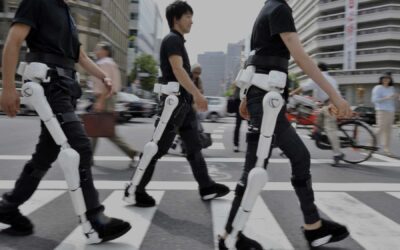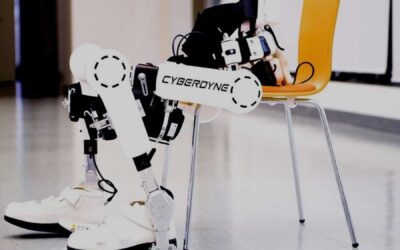Any movement in the body causes the brain to send bioelectrical impulses to the muscles that enable mobility. Such signals from paralysed or impaired people may be insufficient to cause adequate movement.
HAL recognises these so-called “bio-electrical signals” on the skin’s surface and performs the appropriate motions in response to the wearer’s voluntary orders.
Neuromuscular feedback treatment significantly improves functional movement in stroke patients. The “Wearable Cyborg™ HAL®” can have several degrees of noticeable impacts, including:
- Reducing nerve aches
- Enhancing bladder and bowel functioning.
HAL Plans and Process for Stroke Patients

- Think-
When someone moves their body, their initial thought is on the movements in their brain. Thinking “I want to walk” causes the brain to send nerve impulses to the muscles that are required for the movement.
- Send Signals-
Every muscle in a healthy body has the ability to accept instructions from the brain and contract with the force and speed desired. But in the case of the Wearable Cyborg – HAL®, it is accomplished with the use of nerve-stimulation technology.
- Read the signals-
The brain transmits extremely weak impulses known as “bio-electric signals [BES]” to muscles, which surface on the skin.All that is needed for HAL® to read BES is for the wearer’s skin to be covered with the original detectors. By combining many sources of data, HAL® is able to identify the types of movements the user wants to make.
- Recognise the movements-
Both humans and Hal can quickly regulate the power unit and process a variety of information that is instantaneously recognised by the brain. HAL begins to move simultaneously with the body’s motion. HAL can therefore facilitate the wearer’s movements.
- Response-
Muscles are not the only component of the human body’s movement system. Based on what kind of messages, the brain validates the movements of the body. The brain receives a signal that “I could walk!” once HAL has adequately aided with the gait.

In this way, the brain progressively picks up the required signalling needed to go “walking.” This results in “the important first step”—walking the disabled person without the aid of Hal®.
The only robot that can offer suitable responses for brain movements is HAL.
A Relief from Stroke Disease
Through the use of peripheral nerves and the spinal cord, the human brain can send voluntary command signals to the musculoskeletal system; however, the real secret to promoting functional improvement with Cyberdyne Treatment lies in the brain’s ability to receive feedback from the sensation of movement itself.
By stimulating the body’s innate potential to repair itself, the functional improvement/regeneration technique utilising Hal® is a cutting-edge therapeutic approach that improves human brain-nerve-musculoskeletal functioning.
The best therapy is tailored to the patient’s demands and long enough and intense enough to really retrain the affected muscles and nerves.
So, connect with us today at https://rehabmodalities.com/ for a free demo of our spectacular journey with Cyberdyne HAL!



